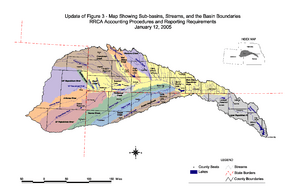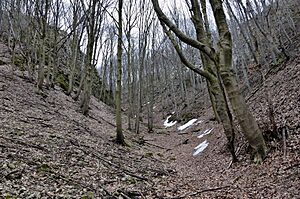Jones-Miller Bison Kill Site facts for kids
The Jones-Miller Bison Kill Site is an important archaeological spot in northeast Colorado. It's where ancient people, called Paleo-Indians, hunted and butchered a type of bison called Bison antiquus. They used a special hunting method called a game drive system. Scientists have used radiocarbon dating to figure out that the bones and tools found here are about 10,000 years old, from around 8000-8050 BC.
Contents
Where is the Jones-Miller Site?
The Jones-Miller site is located in Yuma County, Colorado. It's about 10 miles from the town of Laird. The site is in the Republican River basin, which is a large area of land drained by the Republican River and its smaller streams.
The site itself is a grassland area. It sits near a shallow valley, known as a draw, which is about 18 inches (46 cm) deep. This draw eventually drains into a stream that flows into the Arikaree River.
A Look Back in Time
Colorado's Ancient Past
Before humans arrived in Colorado, about 16,000 years ago, it was the end of the Ice Age. Huge animals roamed the land, like mastodons, mammoths, giant sloths, and ancient horses. There were also large Bison antiquus.
The first people in Colorado were the Paleo-Indians. They had different cultures, known by the types of tools they used and the animals they hunted. The earliest Paleo-Indians, from the Clovis culture, used large tools to hunt these giant animals, known as megafauna.
Changes in Climate and Hunting
Around 11,000 years ago (9,000 BC), the climate started to get warmer. Lakes and savannas, which are grassy plains, began to shrink. The land became drier, and food became harder to find. Because of these changes, many of the giant animals became extinct.
People had to adapt to these new conditions. They started hunting smaller animals and gathering wild plants to add to their diet. This led to a new culture called the Folsom tradition. These people used smaller, more refined projectile points to hunt smaller animals.
The Lindenmeier Site is another famous Paleo-Indian Folsom site in Colorado. It shows how people lived and hunted around 11,000 years ago. They used special Folsom points to hunt the large, now-extinct Bison antiquus. These people were nomadic, meaning they moved around a lot, following the bison herds and setting up camps in many different places throughout the year.
Discovering the Jones-Miller Site
Finding the Ancient Hunt Site
In 1972, Robert Jones, Jr., a rancher near Wray, Colorado, found some old bones and projectile points on his land. He told Jack Miller, a local expert on ancient cultures. Miller did a small dig and found more bones and Paleo-Indian tools.
They then contacted Dennis Stanford, an archaeologist from the Smithsonian Institution. Between 1973 and 1978, a large-scale excavation took place at the Jones-Miller site. It turned out to be mainly a bison kill site. In 1986, archaeologist Waldo Rudolph Wedel called it the "most carefully studied bison kill" site.
Archaeologists learned a lot about how early native people hunted large animals from the artifacts at the Jones-Miller site. They found the remains of about 300 bison in a draw, which is a small, dry streambed, above the Arikaree River basin.
It's believed that the bison were cleverly guided into this draw, which made it hard for them to move and easier for hunters to kill them. Many of the animals were young calves, which suggests the hunts happened in the late fall or winter. The bison bones were piled into many stacks, showing that there were several places where the animals were butchered.
Tools and Ancient Beliefs
Many artifacts were found at the site. These include Hell Gap complex projectile points, which are spear tips, along with flakes (small pieces of stone), knives, scrapers, and tools made from bone.
While it's hard to know exactly what ancient people believed, some artifacts at the Jones-Miller site suggest they might have had special ceremonies. For example, a projectile point, dog remains, and an antler flute were found grouped together among the bison bones. This is similar to the "medicine post" ceremonies of later Native American groups like the Cree and Assiniboine people.
The site is dated to about 10,020 years ago, or around 8000 BC. It's the only site of its kind in Colorado that shows evidence of the Hell Gap culture, which is more commonly found in Wyoming.
The Collection Today
The artifacts found during the Smithsonian Institution's excavation in the 1970s were given to the Denver Museum of Nature and Science in 1997. This collection, called the "Jones-Miller Hell Gap Bison Kill Site Collection," includes bison bones, projectile points, and various stone tools.




